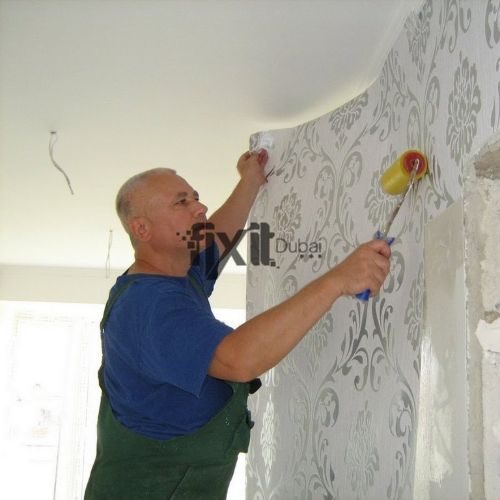Easy Guide to Wallpaper Fixing and Wall Panel Installation for a Stunning Home
Easy Guide to Wallpaper Fixing and Wall Panel Installation for a Stunning Home
Blog Article
Wallpaper fixing and wall panel installation are two popular ways to enhance the look of your home. Both options provide a unique touch to any room, giving it a fresh and modern feel. Whether you’re updating your living room, bedroom, or even your office, these decorative elements can transform your walls into beautiful features. In this guide, we’ll explore how wallpaper fixing and wall panel ing can elevate your space while offering practical tips for installation.

Wallpaper Fixing: Transform Your Walls with Style
Wallpaper is an effective way to add texture, color, and personality to a room. Unlike traditional paint, wallpaper provides a variety of designs, from floral patterns to bold geometric prints. With the right wallpaper, you can create a feature wall or transform the entire room.
Why Choose Wallpaper? Wallpaper offers a wide range of design options, from classic floral prints to contemporary abstract patterns. The diversity of styles makes wallpaper an ideal choice for almost any room. Additionally, wallpaper can help hide imperfections on the wall, such as cracks or uneven surfaces, which can be difficult to address with paint alone.
The Benefits of Wallpaper Wallpaper is not just about style; it also provides several practical benefits. It’s durable and long-lasting, often outlasting paint by several years. High-quality wallpapers are also easy to clean, making them a practical choice for high-traffic areas or homes with children and pets. Moreover, wallpaper can add insulation and reduce noise, creating a more comfortable living environment.
Preparing for Wallpaper Fixing Before you start wallpaper fixing, it’s important to properly prepare the wall. Begin by cleaning the surface to remove any dust or debris. If there are any holes or cracks, patch them up with a wall filler. Once the surface is smooth and dry, measure the wall and cut the wallpaper into the appropriate sizes for easy application.
Applying Wallpaper Wallpaper application can be a straightforward process with the right tools. Start by applying wallpaper adhesive to the back of the wallpaper, making sure it’s evenly distributed. Align the top edge of the wallpaper with the ceiling and press it onto the wall, smoothing out any air bubbles. Use a wallpaper brush or roller to ensure the wallpaper sticks firmly to the wall. Finally, trim any excess wallpaper at the edges for a clean finish.
Wall Panels: A Stylish and Practical Addition
Wall panels are another excellent way to enhance the look of your space. They come in a variety of materials, such as wood, PVC, or MDF, and can be used to create a stylish, modern look. Wall paneling is often used in living rooms, offices, and even bathrooms to add depth and texture to the walls.
Why Choose Wall Panels? Wall panels provide a sleek, sophisticated appearance that can instantly upgrade any room. They are available in various finishes, from wood paneling that creates a warm, rustic feel, to sleek, modern panels that add a minimalist touch. Wall panels can also improve the insulation of a room by reducing heat loss and controlling noise, which can be especially beneficial in larger homes or offices.
The Advantages of Wall Paneling In addition to their aesthetic appeal, wall panels are highly durable and easy to maintain. Unlike wallpaper, which may require periodic touch-ups, wall panels typically last longer and are less likely to show wear and tear. They are also easy to clean, especially when made of materials like PVC or MDF. Wall panels can even be installed in areas that are exposed to moisture, such as bathrooms or kitchens, as many options are water-resistant.
Installing Wall Panels Installing wall panels can be a DIY project, but it requires careful planning and the right tools. Start by measuring the walls to determine how many panels you will need. If you’re using wood panels, ensure the surface is smooth and dry. For most paneling options, you’ll need a strong adhesive to secure the panels to the wall. Alternatively, some panels come with a tongue-and-groove system, making it easier to interlock and install them without adhesive. Once the panels are in place, use a trim to cover the edges for a professional finish.
Combining Wallpaper Fixing and Wall Paneling
While wallpaper fixing and wall paneling are both excellent ways to improve your walls, you don’t have to choose just one. Combining the two can create a stunning look that’s both stylish and functional.
Create a Feature Wall One popular approach is to use wallpaper on one wall as a feature, while the other walls are adorned with wall panels. This creates a focal point in the room and adds visual interest. For instance, you could apply a bold, patterned wallpaper on the wall behind your TV or bed, while using sleek, wooden panels on the remaining walls to create a balanced look.
Mix and Match Materials Another way to combine wallpaper and wall panels is by mixing materials. For example, you could use textured wallpaper on the upper half of the wall and complement it with wood or PVC panels on the lower half. This creates a layered, dynamic effect that adds depth to the room. The key is to choose materials and designs that complement each other to avoid overwhelming the space.
Create a Modern Look with Panels and Wallpaper If you prefer a modern, clean aesthetic, consider using minimalist wallpaper designs with subtle patterns, paired with sleek, contemporary panels. This combination works well in living rooms, offices, and even kitchens, providing a polished, modern look without being too flashy.